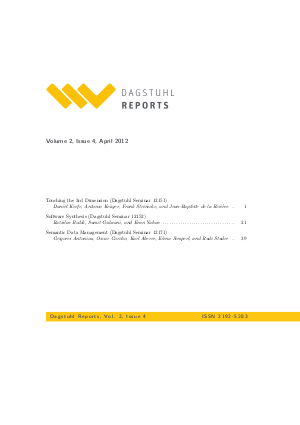Dagstuhl Reports, Volume 2, Issue 4
-
Part of:
Volume:
Dagstuhl Reports, Volume 2
Journal: Dagstuhl Reports (DagRep)

Event
- Dagstuhl Seminars 12151, 12152, 12171
Publication Details
- published at: 2012-09-24
- Publisher: Schloss Dagstuhl – Leibniz-Zentrum für Informatik
- DBLP: db/journals/dagstuhl-reports/dagstuhl-reports2
Access Numbers
- Detailed Access Statistics available here
-
Total Document Accesses (updated on a weekly basis):
0PDF Downloads
Documents
Dagstuhl Reports, Volume 2, Issue 4, April 2012, Complete Issue
Abstract
Cite as
Dagstuhl Reports, Volume 2, Issue 4, Schloss Dagstuhl – Leibniz-Zentrum für Informatik (2012)
Copy BibTex To Clipboard
@Article{DagRep.2.4,
title = {{Dagstuhl Reports, Volume 2, Issue 4, April 2012, Complete Issue}},
journal = {Dagstuhl Reports},
ISSN = {2192-5283},
year = {2012},
volume = {2},
number = {4},
publisher = {Schloss Dagstuhl -- Leibniz-Zentrum f{\"u}r Informatik},
address = {Dagstuhl, Germany},
URL = {https://drops.dagstuhl.de/entities/document/10.4230/DagRep.2.4},
URN = {urn:nbn:de:0030-drops-37336},
doi = {10.4230/DagRep.2.4},
annote = {Keywords: Dagstuhl Reports, Volume 2, Issue 4, April 2012, Complete Issue}
}
Dagstuhl Reports, Table of Contents, Volume 2, Issue 4, 2012
Abstract
Cite as
Dagstuhl Reports, Volume 2, Issue 4, pp. i-ii, Schloss Dagstuhl – Leibniz-Zentrum für Informatik (2012)
Copy BibTex To Clipboard
@Article{DagRep.2.4.i,
title = {{Dagstuhl Reports, Table of Contents, Volume 2, Issue 4, 2012}},
pages = {i--ii},
journal = {Dagstuhl Reports},
ISSN = {2192-5283},
year = {2012},
volume = {2},
number = {4},
publisher = {Schloss Dagstuhl -- Leibniz-Zentrum f{\"u}r Informatik},
address = {Dagstuhl, Germany},
URL = {https://drops.dagstuhl.de/entities/document/10.4230/DagRep.2.4.i},
URN = {urn:nbn:de:0030-drops-37320},
doi = {10.4230/DagRep.2.4.i},
annote = {Keywords: Dagstuhl Reports, Table of Contents, Volume 2, Issue 4, 2012}
}
Touching the 3rd Dimension (Dagstuhl Seminar 12151)
Abstract
Cite as
Daniel Keefe, Antonio Krüger, Frank Steinicke, and Jean-Baptiste de la Rivière. Touching the 3rd Dimension (Dagstuhl Seminar 12151). In Dagstuhl Reports, Volume 2, Issue 4, pp. 1-20, Schloss Dagstuhl – Leibniz-Zentrum für Informatik (2012)
Copy BibTex To Clipboard
@Article{keefe_et_al:DagRep.2.4.1,
author = {Keefe, Daniel and Kr\"{u}ger, Antonio and Steinicke, Frank and de la Rivi\`{e}re, Jean-Baptiste},
title = {{Touching the 3rd Dimension (Dagstuhl Seminar 12151)}},
pages = {1--20},
journal = {Dagstuhl Reports},
ISSN = {2192-5283},
year = {2012},
volume = {2},
number = {4},
editor = {Keefe, Daniel and Kr\"{u}ger, Antonio and Steinicke, Frank and de la Rivi\`{e}re, Jean-Baptiste},
publisher = {Schloss Dagstuhl -- Leibniz-Zentrum f{\"u}r Informatik},
address = {Dagstuhl, Germany},
URL = {https://drops.dagstuhl.de/entities/document/10.4230/DagRep.2.4.1},
URN = {urn:nbn:de:0030-drops-35946},
doi = {10.4230/DagRep.2.4.1},
annote = {Keywords: Multi-touch Technology, Stereoscopic Visualization, 3D User Interfaces}
}
Software Synthesis (Dagstuhl Seminar 12152)
Abstract
Cite as
Rastislav Bodík, Sumit Gulwani, and Eran Yahav. Software Synthesis (Dagstuhl Seminar 12152). In Dagstuhl Reports, Volume 2, Issue 4, pp. 21-38, Schloss Dagstuhl – Leibniz-Zentrum für Informatik (2012)
Copy BibTex To Clipboard
@Article{bodik_et_al:DagRep.2.4.21,
author = {Bod{\'\i}k, Rastislav and Gulwani, Sumit and Yahav, Eran},
title = {{Software Synthesis (Dagstuhl Seminar 12152)}},
pages = {21--38},
journal = {Dagstuhl Reports},
ISSN = {2192-5283},
year = {2012},
volume = {2},
number = {4},
editor = {Bod{\'\i}k, Rastislav and Gulwani, Sumit and Yahav, Eran},
publisher = {Schloss Dagstuhl -- Leibniz-Zentrum f{\"u}r Informatik},
address = {Dagstuhl, Germany},
URL = {https://drops.dagstuhl.de/entities/document/10.4230/DagRep.2.4.21},
URN = {urn:nbn:de:0030-drops-35956},
doi = {10.4230/DagRep.2.4.21},
annote = {Keywords: Software Synthesis, Verification and Model Checking, Theorem Proving, Program Analysis, Programming by Demonstration, Program Derivation, Compiler Optimization}
}
Semantic Data Management (Dagstuhl Seminar 12171)
Abstract
Cite as
Grigoris Antoniou, Oscar Corcho, Karl Aberer, Elena Simperl, and Rudi Studer. Semantic Data Management (Dagstuhl Seminar 12171). In Dagstuhl Reports, Volume 2, Issue 4, pp. 39-65, Schloss Dagstuhl – Leibniz-Zentrum für Informatik (2012)
Copy BibTex To Clipboard
@Article{antoniou_et_al:DagRep.2.4.39,
author = {Antoniou, Grigoris and Corcho, Oscar and Aberer, Karl and Simperl, Elena and Studer, Rudi},
title = {{Semantic Data Management (Dagstuhl Seminar 12171)}},
pages = {39--65},
journal = {Dagstuhl Reports},
ISSN = {2192-5283},
year = {2012},
volume = {2},
number = {4},
editor = {Antoniou, Grigoris and Corcho, Oscar and Aberer, Karl and Simperl, Elena and Studer, Rudi},
publisher = {Schloss Dagstuhl -- Leibniz-Zentrum f{\"u}r Informatik},
address = {Dagstuhl, Germany},
URL = {https://drops.dagstuhl.de/entities/document/10.4230/DagRep.2.4.39},
URN = {urn:nbn:de:0030-drops-35976},
doi = {10.4230/DagRep.2.4.39},
annote = {Keywords: Semantic data, Semantic Web, Linked Data, Large-scale data management, Dynamicity and stream processing, Provenance and access control, Information retrieval and ranking}
}